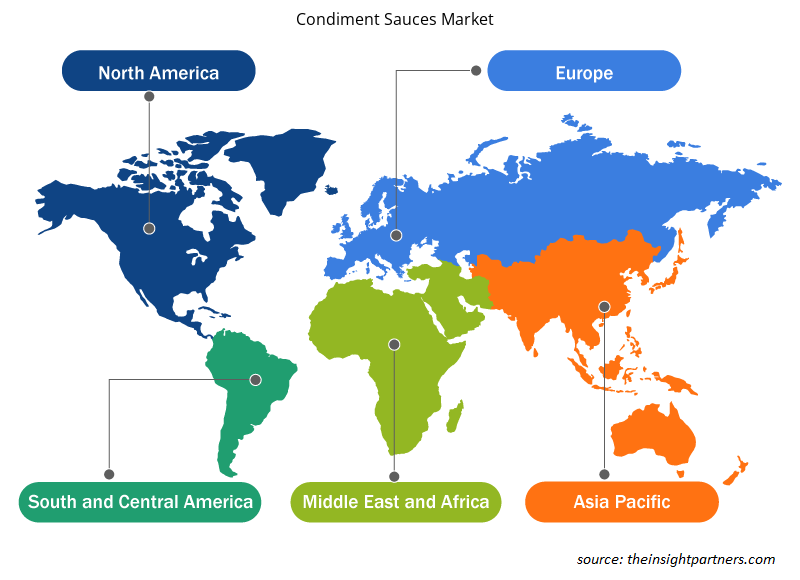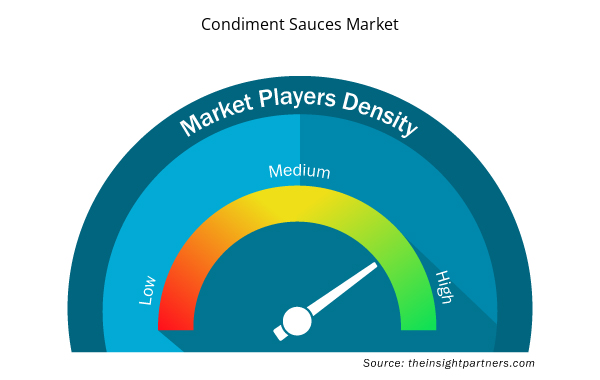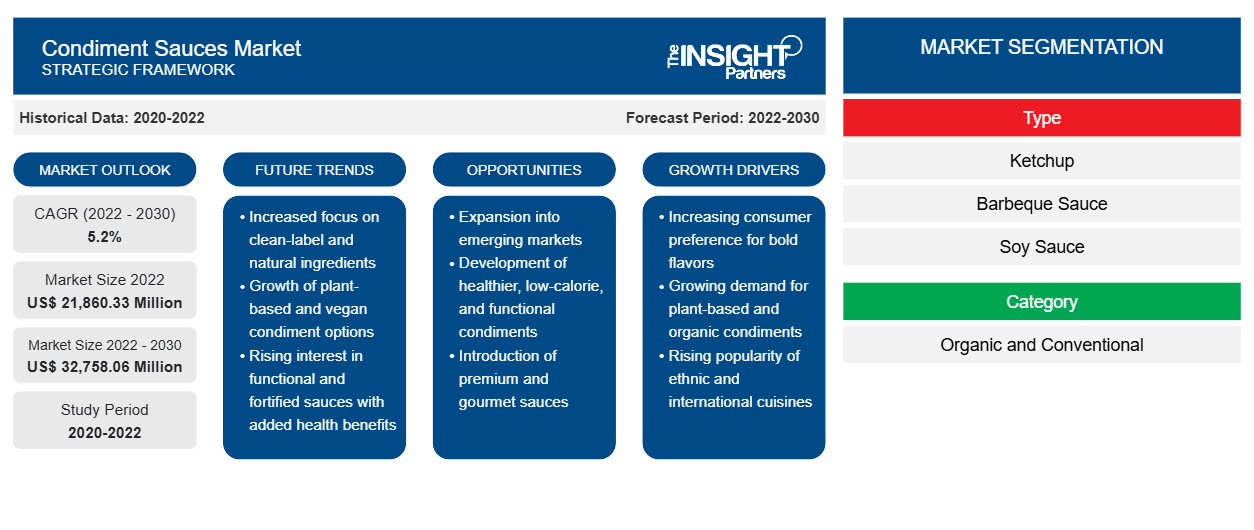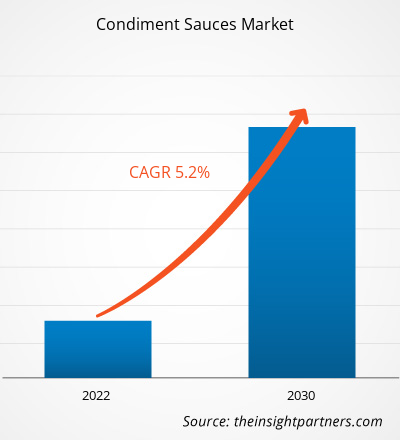[研究报告] 调味酱市场规模预计将从 2022 年的 218.6033 亿美元增长到 2030 年的 327.5806 亿美元;预计 2022 年至 2030 年的复合年增长率为 5.2%。
市场洞察和分析师观点:
用香草、香料、调味料、调味品和色素调味的酱汁被称为调味酱。调味酱在各种烹饪食谱和餐点中被广泛使用。烧烤酱、酱油、照烧酱、辣椒酱、芥末酱和其他调味酱在全球调味酱市场上随处可见。酱汁可用作调味品和蘸料的餐桌酱汁以及烹饪原料。酱汁、黄油、调味酱、果酱和果冻、沙拉酱和各种其他调味品可用于丰富餐点。消费者口味偏好的变化以及对尝试亚洲美食和其他大陆新菜肴的兴趣日益浓厚,有利于全球调味酱市场的增长。
增长动力和挑战:
全球消费者越来越多地接受各种口味的国际美食,从亚洲、中东、拉丁美洲到非洲美食。此外,美食旅游的兴起和烹饪节目的流行也促使消费者希望在家中复制多样化和精致的口味。这一因素预计将带来新的调味酱市场趋势。此外,美食博主、影响者和在线社区在社交媒体和数字平台上分享独特调味酱的食谱、烹饪技巧和推荐。这个互联的虚拟空间使他们能够发现和探索许多调味酱选项,培养实验文化,推动对新口味和令人兴奋的口味的需求。这些因素在确定调味酱市场预测方面发挥着重要作用。
消费者越来越喜欢多样化和全球风味。这种好奇心和尝试新美食的开放性创造了对方便正宗的调味酱选择的需求,这些调味酱可以增强和定制各种菜肴的味道,并提升整体用餐体验。制造商还推出了异国风味的调味酱,例如受不同烹饪传统启发的独特特色酱。此外,一些生产商推出了用优质天然原料制成的手工、美食和小批量调味酱,为消费者提供符合他们冒险口味的高品质选择。这些因素推动了调味酱市场的增长。
寻找替代供应商、加快运输或应对供应链中不可预见的挑战导致成本增加,从而导致产品价格波动。这些波动可能对生产者和消费者造成挑战,并可能影响购买决策和整体市场动态。
定制此报告以满足您的需求
您可以免费定制任何报告,包括本报告的部分内容、国家级分析、Excel 数据包,以及为初创企业和大学提供优惠和折扣
- 获取此报告的关键市场趋势。这个免费样品将包括数据分析,从市场趋势到估计和预测。
报告细分和范围:
调味酱市场分析考虑了以下几个部分:类型、类别、分销渠道和地域。市场按类型细分为番茄酱、烧烤酱、酱油、芥末酱、辣椒酱等。根据类别,市场分为有机和传统。根据分销渠道,市场细分为超市和大卖场、便利店、在线零售和其他。按地域划分,调味酱市场细分为北美(美国、加拿大和墨西哥)、欧洲(德国、法国、意大利、英国、俄罗斯和欧洲其他地区)、亚太地区(澳大利亚、中国、日本、印度、韩国和亚太地区其他地区)、中东和非洲(南非、沙特阿拉伯、阿联酋和中东和非洲其他地区)以及南美洲和中美洲(巴西、阿根廷和南美洲和中美洲其他地区)。
节段分析:
根据类别,调味酱市场分为有机和传统。传统部分占全球调味酱市场的很大份额。然而,有机部分的市场预计在预测期内将大幅增长。消费者越来越注重健康,改变了他们的食物选择,优先考虑符合健康和可持续价值的产品。有机调味酱,不使用合成农药、除草剂或转基因生物 (GMO) 生产,被认为是更健康的选择。这些产品吸引了那些希望减少接触传统调味品中常见的潜在有害添加剂和化学物质的消费者。这些因素将在预测期内促进有机部分的市场增长。
区域分析:
根据地域,调味酱市场报告的范围主要分为五个地区——北美、欧洲、亚太、南美和中美以及中东和非洲。2022 年,北美占据了全球调味酱市场份额的主导地位。2022 年该地区的市场价值为 73.0135 亿美元。然而,预计亚太地区市场在预测期内的复合年增长率将达到 6.2%。快餐店(也称为快餐店 (QSR))的日益普及,主要推动了亚太地区市场的增长。
中国、日本和印度是调味酱的最大消费国,因为这些国家人口基数庞大,汉堡王、麦当劳、温迪、赛百味和唐恩都乐等快餐店数量激增。这些门店依靠调味酱、果泥、腌料等来提升所供应食品的口感和视觉吸引力,从而推动了该地区调味酱市场的增长。因此,随着市场的增长,全球制造商正在该地区进行大量投资以发展业务。2022 年 6 月,Del Monte 在印度推出了芥末酱,以获取利润并保持其在该地区的竞争地位。制造商的此类战略举措进一步提升了亚太地区调味酱市场的份额。
调味酱市场区域洞察
Insight Partners 的分析师已详尽解释了预测期内影响调味酱市场的区域趋势和因素。本节还讨论了北美、欧洲、亚太地区、中东和非洲以及南美和中美洲的调味酱市场细分和地理位置。

- 获取调味酱市场的区域特定数据
调味酱市场报告范围
| 报告属性 | 细节 |
|---|---|
| 2022 年市场规模 | 218.6033亿美元 |
| 2030 年的市场规模 | 327.5806 亿美元 |
| 全球复合年增长率(2022 - 2030 年) | 5.2% |
| 史料 | 2020-2022 |
| 预测期 | 2022-2030 |
| 涵盖的领域 | 按类型
|
| 覆盖地区和国家 | 北美
|
| 市场领导者和主要公司简介 |
|
调味酱市场参与者密度:了解其对业务动态的影响
调味酱市场正在快速增长,这得益于最终用户需求的增加,这些需求是由于消费者偏好的不断变化、技术进步以及对产品优势的认识不断提高等因素所致。随着需求的增加,企业正在扩大其产品范围,进行创新以满足消费者的需求,并利用新兴趋势,从而进一步推动市场增长。
市场参与者密度是指在特定市场或行业内运营的企业或公司的分布情况。它表明在给定市场空间中,相对于其规模或总市场价值,有多少竞争对手(市场参与者)存在。
在调味酱市场运营的主要公司有:
- 雀巢公司
- 德维利森夫与费因科斯特有限公司
- 德尔蒙特国际有限公司
- 味好美公司
- 梅琳达
免责声明:上面列出的公司没有按照任何特定顺序排列。

- 了解调味酱市场顶级关键参与者概况
行业发展和未来机遇:
全球调味酱市场主要参与者采取的举措如下:
- 2023 年,调味品品牌 Primal Kitchen 在其食品主食系列中增加了五款创新新产品。新产品包括有机韩式烧烤酱、有机蜂蜜照烧酱、温和甜味水牛城辣酱、微甜有机番茄酱和鲜奶油酱。
- 2022 年 5 月,印度调味酱公司 Veeba 推出了多款产品,包括 Prime 辣鸡翅酱、Prime 番茄酱小袋和辣椒酱小袋。
- 2022 年 6 月,McCormick & Company 推出了“Old Bay 辣酱”限量版。
竞争格局和重点公司:
雀巢公司、Develey Senf & Feinkost GmbH、Del Monte International GmbH、McCormick & Co Inc、Melinda's Foods LLC、Kikkoman Corp、卡夫亨氏公司、Ken's Foods Inc、TW Garner Food Co 和 The Smokey Carter 是全球调味酱市场报告中的知名企业。这些市场参与者采取战略发展举措,扩大其全球业务,进一步推动调味酱市场的增长。
- 历史分析(2 年)、基准年、预测(7 年)及复合年增长率
- PEST 和 SWOT 分析
- 市场规模价值/数量 - 全球、区域、国家
- 行业和竞争格局
- Excel 数据集



Report Coverage
Revenue forecast, Company Analysis, Industry landscape, Growth factors, and Trends

Segment Covered
This text is related
to segments covered.

Regional Scope
North America, Europe, Asia Pacific, Middle East & Africa, South & Central America

Country Scope
This text is related
to country scope.
常见问题
Nestle SA, Develey Senf & Feinkost GmbH, Del Monte International GmbH, McCormick & Co Inc, Melinda’s Foods LLC, Kikkoman Corp, Kraft Heinz Co, Ken's Foods Inc, TW Garner Food Co, and The Smokey Carter are a few players operating in the global condiment sauces market.
In 2022, Asia Pacific held the largest share of the global condiment sauces market. The food and beverage industry in Asia Pacific is rapidly growing with rising consumption of convenience food and. This factor significantly drives the demand for condiment sauces market in the food and beverages industry across Asia Pacific.
Growing preference for organic and non-GMO products expected to bring new trend in the condiment sauces market.
Based on type, the ketchup segment held the largest share in the global condiment sauces market in 2022. tomato ketchup is a popular accompaniment to various dishes such as burgers, fries, hot dogs, and sandwiches. Its demand is upsurging due to its widespread appeal and role as a staple in households.
Based on distribution channel, the convenience stores segment is estimated to register the largest market share in global condiment sauces market as the convenience stores have wide product availability and thy are easy to reach.
Surging interest in culinary exploration and availability of diverse range of condiment sauces are the two key factors driving the condiment sauces market growth.
Trends and growth analysis reports related to Food and Beverages : READ MORE..
The List of Companies - Condiment Sauces Market
- Nestle SA
- Develey Senf & Feinkost GmbH
- Del Monte International GmbH
- McCormick & Co Inc
- Melinda’s Foods LLC
- Kikkoman Corp
- Kraft Heinz Co
- Ken's Foods Inc
- TW Garner Food Co
- The Smokey Carter
The Insight Partners performs research in 4 major stages: Data Collection & Secondary Research, Primary Research, Data Analysis and Data Triangulation & Final Review.
- Data Collection and Secondary Research:
As a market research and consulting firm operating from a decade, we have published and advised several client across the globe. First step for any study will start with an assessment of currently available data and insights from existing reports. Further, historical and current market information is collected from Investor Presentations, Annual Reports, SEC Filings, etc., and other information related to company’s performance and market positioning are gathered from Paid Databases (Factiva, Hoovers, and Reuters) and various other publications available in public domain.
Several associations trade associates, technical forums, institutes, societies and organization are accessed to gain technical as well as market related insights through their publications such as research papers, blogs and press releases related to the studies are referred to get cues about the market. Further, white papers, journals, magazines, and other news articles published in last 3 years are scrutinized and analyzed to understand the current market trends.
- Primary Research:
The primarily interview analysis comprise of data obtained from industry participants interview and answers to survey questions gathered by in-house primary team.
For primary research, interviews are conducted with industry experts/CEOs/Marketing Managers/VPs/Subject Matter Experts from both demand and supply side to get a 360-degree view of the market. The primary team conducts several interviews based on the complexity of the markets to understand the various market trends and dynamics which makes research more credible and precise.
A typical research interview fulfils the following functions:
- Provides first-hand information on the market size, market trends, growth trends, competitive landscape, and outlook
- Validates and strengthens in-house secondary research findings
- Develops the analysis team’s expertise and market understanding
Primary research involves email interactions and telephone interviews for each market, category, segment, and sub-segment across geographies. The participants who typically take part in such a process include, but are not limited to:
- Industry participants: VPs, business development managers, market intelligence managers and national sales managers
- Outside experts: Valuation experts, research analysts and key opinion leaders specializing in the electronics and semiconductor industry.
Below is the breakup of our primary respondents by company, designation, and region:

Once we receive the confirmation from primary research sources or primary respondents, we finalize the base year market estimation and forecast the data as per the macroeconomic and microeconomic factors assessed during data collection.
- Data Analysis:
Once data is validated through both secondary as well as primary respondents, we finalize the market estimations by hypothesis formulation and factor analysis at regional and country level.
- Macro-Economic Factor Analysis:
We analyse macroeconomic indicators such the gross domestic product (GDP), increase in the demand for goods and services across industries, technological advancement, regional economic growth, governmental policies, the influence of COVID-19, PEST analysis, and other aspects. This analysis aids in setting benchmarks for various nations/regions and approximating market splits. Additionally, the general trend of the aforementioned components aid in determining the market's development possibilities.
- Country Level Data:
Various factors that are especially aligned to the country are taken into account to determine the market size for a certain area and country, including the presence of vendors, such as headquarters and offices, the country's GDP, demand patterns, and industry growth. To comprehend the market dynamics for the nation, a number of growth variables, inhibitors, application areas, and current market trends are researched. The aforementioned elements aid in determining the country's overall market's growth potential.
- Company Profile:
The “Table of Contents” is formulated by listing and analyzing more than 25 - 30 companies operating in the market ecosystem across geographies. However, we profile only 10 companies as a standard practice in our syndicate reports. These 10 companies comprise leading, emerging, and regional players. Nonetheless, our analysis is not restricted to the 10 listed companies, we also analyze other companies present in the market to develop a holistic view and understand the prevailing trends. The “Company Profiles” section in the report covers key facts, business description, products & services, financial information, SWOT analysis, and key developments. The financial information presented is extracted from the annual reports and official documents of the publicly listed companies. Upon collecting the information for the sections of respective companies, we verify them via various primary sources and then compile the data in respective company profiles. The company level information helps us in deriving the base number as well as in forecasting the market size.
- Developing Base Number:
Aggregation of sales statistics (2020-2022) and macro-economic factor, and other secondary and primary research insights are utilized to arrive at base number and related market shares for 2022. The data gaps are identified in this step and relevant market data is analyzed, collected from paid primary interviews or databases. On finalizing the base year market size, forecasts are developed on the basis of macro-economic, industry and market growth factors and company level analysis.
- Data Triangulation and Final Review:
The market findings and base year market size calculations are validated from supply as well as demand side. Demand side validations are based on macro-economic factor analysis and benchmarks for respective regions and countries. In case of supply side validations, revenues of major companies are estimated (in case not available) based on industry benchmark, approximate number of employees, product portfolio, and primary interviews revenues are gathered. Further revenue from target product/service segment is assessed to avoid overshooting of market statistics. In case of heavy deviations between supply and demand side values, all thes steps are repeated to achieve synchronization.
We follow an iterative model, wherein we share our research findings with Subject Matter Experts (SME’s) and Key Opinion Leaders (KOLs) until consensus view of the market is not formulated – this model negates any drastic deviation in the opinions of experts. Only validated and universally acceptable research findings are quoted in our reports.
We have important check points that we use to validate our research findings – which we call – data triangulation, where we validate the information, we generate from secondary sources with primary interviews and then we re-validate with our internal data bases and Subject matter experts. This comprehensive model enables us to deliver high quality, reliable data in shortest possible time.


 获取此报告的免费样本
获取此报告的免费样本